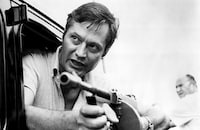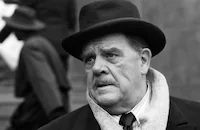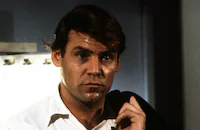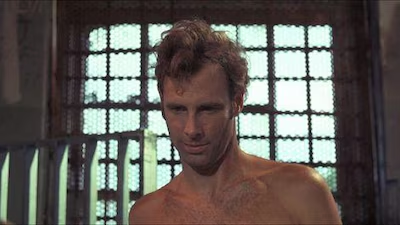Bloody Mama

Brief Synopsis
Cast & Crew
Roger Corman
Shelley Winters
Pat Hingle
Don Stroud
Diane Varsi
Bruce Dern
Film Details
Technical Specs

Synopsis
Raped by her brothers at age seven, Ma Barker exacts absolute loyalty from her four sons, sadistic Herman, narcotics addict Lloyd, soft-spoken Arthur, and homosexual Fred. During the Depression Ma and her brood leave passive Pa Barker and the Ozarks to begin a criminal career. While robbing a ferryboat eldest son Herman loses his temper and stomps a passenger to death. To console Herman, Ma sleeps with him. Apprehended robbing a picnic, Fred and Herman are incarcerated. In prison Fred succumbs to the advances of Kevin Dirkman, who becomes Ma's lover upon release. Over her protests Herman introduces his mistress, the prostitute Mona, into the band. After Lloyd rapes local resident Rembrandt, Ma, Herman, and Kevin drown the girl in the bathtub. Later Lloyd dies of a drug overdose. The gang then kidnaps congenial multi-millionaire Sam Adams Pendlebury. Upon payment of the ransom Ma insists that the hostage be killed. Her sons, however, release the multi-millionaire and Herman assumes command of the band. At their Lake Weir hideout Herman and Kevin unknowingly reveal their identities by firing machine guns at an alligator. Trapped by police, the Barkers fight to the finish, Ma being the last to fall.

Director

Roger Corman
Cast

Shelley Winters

Pat Hingle

Don Stroud
Diane Varsi

Bruce Dern
Clint Kimbrough

Robert De Niro
Robert Walden

Alex Nicol
Michael Fox

Scatman Crothers
Stacy Harris
Pamela Dunlap
Lisa Jill
Steve Mitchell
Roy Idom
Crew
John Alonzo
Samuel Z. Arkoff
Samuel Z. Arkoff
William Bond Jr.
Cinefx
Roger Corman
Thomas Costumesich
Edit-international
John Elsenbach
A. D. Flowers
Michael J. Freeman
David Grayson
Gary Grillo
Guy Hemric
Norman Herman
Roy Hogstedt
Betty Iverson
Richard King
Charles Knight
Michael Levesque
Joseph Marquette Jr.
Tom Moore
Eve Newman
James H. Nicholson
James H. Nicholson
Donald A. Peters
Don Randi
Don Randi
Michael Ross
Elliot Schick
Don Sharpless
Bob Silver
Al Simms
Robert Thom
Robert Thom
Robert E. Thomas
Bud Walls

Videos
Movie Clip




Trailer
Film Details
Technical Specs

Articles
Bloody Mama
Roger Corman had agreed to make Bloody Mama (1970) for American International Pictures with a mind toward cashing in on the success of Arthur Penn's Bonnie and Clyde (1967) but the sociopolitical and violence of the following year (in particular, the assassinations of civil rights leader Martin Luther King, Jr., and presidential hopeful Robert F. Kennedy within two months of one another) prompted Corman to table the project. By the end of 1969, Corman felt the timing was at last right to unleash Bloody Mama upon American moviegoers. To play the eponymous criminal matriarch, Corman cast Shelley Winters, a two-time Academy Award winner then transitioning from leading lady roles to character parts. (Winters had already played a comic variation on the historical figure, as supervillain Ma Parker on TV's Batman.) It was Winters's inspiration to assign the part of Barker's heroin-addicted son Lloyd to Robert DeNiro, whose resume to that point consisted of roles in New York-based experimental and independent films (most notably those of Brian De Palma). Additional parts were meted out to Don Stroud, Clint Kimbrough, and Robert Walden (as Ma Barker's other sons), Pat Hingle as a wealthy kidnap victim, former Peyton Place star Diane Varsi as an Ozarks gun moll, and Bruce Dern as a character patterned after Ma Barker's alleged partner in crime, Alvin "Creepy" Karpis.
With a budget of $600,000, Bloody Mama began filming in Batesville, Arkansas, in August 1969. As triple digit temperatures and faulty air conditioners tested the mettle of the hired talent (in particular winters, who became a flight risk until repairs to her trailer's cooling unit could be made), the film's inclusion of onscreen nudity prompted several locally-hired extras to flee for the sanctity of their church groups. Though cast and crew got along famously through the four weeks of principal photography (which wrapped in Little Rock in September), Winters and DeNiro often seemed to be in competition to see who was more dedicated to the Stanislavsky "Method." While Winters had to pack on extra pounds to play the famously corpulent Kate Barker, DeNiro shed thirty to sell the effects of Lloyd Barker's opiate addiction. When it came time for Winters to film the funeral scene for DeNiro's character, the actress whipped herself up into an emotive frenzy by blasting Italian opera; even though he had been wrapped from the production following his death scene, DeNiro stuck around for the funeral, even dropping down into the freshly-dug grave to give his onscreen family something to cry about. The vibe of verisimilitude prevailed and in another scene, in which Winters was required to slap Don Stroud, Stroud reacted in character and punched back, knocking Winters to the ground and sending her to a local hospital for x-rays.
Bloody Mama made money for AIP but Corman realized the central casting of the nearly 50 year-old Winters had hurt ticket sales. He hired budding filmmaker Martin Scorsese to helm another Depression era gangster tale, Boxcar Bertha (1972), this time starring 23 year-old Barbara Hershey. Breaking with AIP, Corman further retooled the Kate Barker mythos with Big Bad Mama (1974), released by his own New World Pictures and starring fortyish Angie Dickinson as the matriarch of a criminal gang of nubile young girls, and Crazy Mama (1975), an early film for filmmaker manqué Jonathan Demme. As for Shelley Winters, the actress would find herself nominated for another Oscar two years later for playing a survivor of maritime disaster in Ronald Neame's The Poseidon Adventure (1972); at the 45th presentation of the Academy Awards in March 1973, Winters would lose the statue to Best Actress in a Supporting Role to Butterflies Are Free's Eileen Heckart, who would go on to play Ma Barker herself in the 1974 NBC telefilm The F.B.I. Story: The FBI versus Alvin Karpis, Public Enemy Number One.
by Richard Harland Smith
Sources:
How I Made a Hundred Movies in Hollywood and Never Lost a Dime by Roger Corman, with Jim Jerome (Da Capo Press, 1998)
'Shooting My Way Out of Trouble': The Films of Roger Corman by Alan Frank (BT Batsford, Ltd., 1998)
Roger Corman: An Unauthorized Life by Beverly Gray (Thunder's Mouth Press, 2000)
Roger Corman Interviews, edited by Constantine Nasr (University Press of Mississippi, 2011)
Roger Corman: Metaphysics on a Shoestring by Alain Silver and James Ursini (Silman-James Press, 2006)
Flying Through Hollywood By the Seat of My Pants: By the Man Who Brought You Was a Teenage Werewolf and Muscle Beach Party by Sam Arkoff, with Richard Trubo (Birch Lane Press, 1992
The Films of Robert DeNiro by Douglas Brode (Citadel Press, 2000)
Untouchable: Robert DeNiro Unauthorized by Andy Dougan (Random House, 2011)
Martin Scorsese: A Biography by Vincent Lo Brutto (Greenwood Publishing Group, 2008)
Crime Movies: An Illustrated History by Carlos Clarens (W. W. Norton & Company, 1980)

Bloody Mama
Quotes
Trivia
Notes
Filmed on location in Arkansas.

Miscellaneous Notes
Released in United States March 1970
Released in United States Winter January 1, 1970
Released in United States Winter January 1, 1970
Released in United States March 1970














